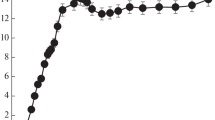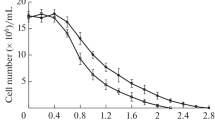Abstract
We discovered that a mutant strain of the dimorphic yeast Yarrowia lipolytica could grow in the yeast form in high concentrations of copper sulfate. The amount of metal accumulated by Y. lipolytica increased with increasing copper concentrations in the medium. Washing with 100 mM EDTA released at least 60% of the total metal from the cells, but about 20–25 μmol/g DW persisted, which represented about 30% of the soluble fraction of cultured cells. The soluble fraction (mainly cytosol) contained only about 10% of the total metal content within cells cultured in medium supplemented with 6 mM copper. We suggest that although a high copper concentration induces an efflux mechanism, the released copper becomes entrapped in the periplasm and in other parts of the cell wall. Washing with EDTA liberated not only copper ions, but also melanin, a brown pigment that can bind metal and which located at the cell wall. These findings indicated that melanin participates in the mechanism of metal accumulation. Culture in medium supplemented with copper obviously enhanced the activities of Cu, Zn-SOD, but not of Mn-SOD.
Similar content being viewed by others
References
Andreishcheva EN, Isakova EP, Sidorov NN, et al. 1999 Adaptation to salt stress in a salt-tolerant strain of the yeast Yarrowia lipolytica. Biochemistry (Moscow) 64:1061–1067
Antonucci S, Bravi M, Bubbico R, Di Michele A, Verdone N. 2001 Selectivity in citric acid production by Yarrowia lipolytica Enzyme Microb Technol 28:189–195
Bartnicki-Garcia S, Nickerson WJ. 1962 Isolation, composition, and structure of cell walls of filamentous and yeast-like forms of Mucor rouxii Biochem Biophys Acta 58:102–119
Barth G, Gaillardin C. 1997 Physiology and genetics of the dimorphic fungus Yarrowia lipolytica. FEMS Microbiol Rev 19:219–237
Borghouts C, Osiewacz HD. 1998 GRISEA, a copper-modulated transcription factor from Podospora anserina involved in senescence and morphogenesis, is an ortholog of MAC1 in Saccharomyces cerevisiae. Mol Gen Genet 260:492–502
Brady D, Duncan JR. 1994 Binding of heavy metals by the cell walls of Saccharomyces cerevisiae. Enzyme Microb Technol 16:633–638
Brady D, Stoll AD, Starke L, Duncan JR. 1994 Chemical and enzymatic extraction of heavy metal binding polymers from isolated cell walls of Saccharomyces cerevisiae Biotechnol Bioeng 44:297–302
Butinar L, Santos S, Spencer-Martins I, Oren A, Gunde-Cimerman N. 2005 Yeast diversity in hypersaline habitats. FEMS Microbiol Lett 244:229–234
Butler MJ, Lazarovits G, Higgins VJ, Lachance MA. 1989 Identification of a black yeast isolated from oak bark as belonging to the genus Phaeococcomyces sp. Analysis of melanin produced by the yeast. Can J Microbiol 35:728–734
Butler MJ, Day AW. 1998 Fungal melanins: a review Can J Microbiol 44:1115–1136
Carreira A, Loureiro V. 1998 A differential medium to detect Yarrowia lipolytica within 24 hours. J Food Mycol 1:3–12
Carreira A, Ferreira LM, Loureiro V. 2001 Brown pigments produced by Yarrowia lipolytica result from extracellular accumulation of homogentisic acid. Appl Environ Microbiol 67:3463–3468
Dancis A, Haile D, Yuan DS, Klausner RD. 1994 The Saccharomyces cerevisiae copper transport protein (Ctr1p). Biochemical characterization, regulation by copper, and physiological role in copper uptake. J Biol Chem 269:25660–25667
Elstner EF, Heupel A. 1976 Inhibition of nitrite formation from hydroxylammonium chloride: a simple assay for superoxide dismutase. Anal Biochem 70:616–620
Elorza MV, Marcilla A, Sentandreu R. 1988 Wall mannoproteins of the yeast and mycelial cells of Candida albicans: nature of the glycosidic bonds and polydispersity of their mannan moieties. J Gen Microbiol 134:2393–2403
Fickers P, Nicaud JM, Gaillardin C, Destain J, Thonart P. 2004 Carbon and nitrogen sources modulate lipase production in the yeast Yarrowia lipolytica. J Appl Microbiol 96:742–749
Fogarty RV, Tobin JM. 1996 Fungal melanins and their interactions with metals. Enzyme Microb Technol 19:311–317
Gadd GM, Griffiths AJ. 1980 Effect of copper on morphology of Aureobasidium pullulans Trans Br Mycol Soc 74:387–392
Gadd GM, de Rome L. 1988 Biosorption of copper by fungal melanin. Appl Microbiol Biotechnol 29:610–617
Gadd GM, Mowll JL. 1985 Copper uptake by yeast-like cells, hyphae, and chlamydospores of Aureobasidium pullulans Exp Mycol 9:230–240
Hurtado CAR, Rachubinski RA. 1999 MHY1 encodes a C2H2-type zinc finger protein that promotes dimorphic transition in the yeast Yarrowia lipolytica. J Bacteriol 181:3051–3057
Jensen LT, Winge DR. 1998 Identification of a copper-induced intramolecular interaction in the transcription factor Mac1 from Saccharomyces cerevisiae. EMBO J 17:5400–5408
Kapoor A, Viraraghavan T. 1997 Heavy metal biosorption sites in Aspergillus niger. Bioresour Technol 61:221–227
Kierans M, Staines AM, Bennett H, Gadd GM. 1991 Silver tolerance and accumulation in yeasts. Biol Met 4:100–106
Lapinskas PJ, Cunningham KW, Liu XF, Fink GR, Culotta VC. 1995 Mutations in PMR1 suppress oxidative damage in yeast cells lacking superoxide dismutase. Mol Cell Biol 15:1382–1388
Lee JK, Kim JM, Kim SW, Nam DH, Yong CS, Huh K. 1996 Effect of copper ion on oxygen damage in superoxide dismutase-deficient Saccharomyces cerevisiae. Arch Pharm Res 19:178–182
Lowry OH, Rosebrough NJ, Farr AL, Randall RJ. 1951 Protein measurement with the Folin phenol reagent. J Biol Chem 193:265–275
Manzano M, Cocolin L, Citterio B, et al. 2000 Biochemical responses in a Candida famata strain adapted to high copper concentrations. BioMetals 13:251–259
Margesin R, Schinner F. 1997 Effect of temperature on oil degradation by a psychrotrophic yeast in liquid culture and in soil. FEMS Microbiol Ecol 24:243–249
Melo RGM, Leitão AC, Pádula M. 2004 Role of OGG1 and NTG2 in the repair of oxidative DNA damage and mutagenesis induced by hydrogen peroxide in Saccharomyces cerevisiae: relationships with transition metals iron and copper. Yeast 21:991–1003
Mowll JL, Gadd GM. 1984 Cadmium uptake by Aureobasidium pullulans. J Gen Microbiol 130:279–284
Naiki N. 1980 Role of superoxide dismutase in a copper-resistant strain of yeast. Plant Cell Physiol 21:775–783
Ramezani Rad M, Kirchrath L, Hollenberg CP. 1994 A putative P-type Cu2+- transporting ATPase gene on chromosome II of Saccharomyces cerevisiae. Yeast 10:1217–1225
Riggle PJ, Kumamoto CA. 2000 Role of a Candida albicans P1-type ATPase in resistance to copper and silver ion toxicity. J Bacteriol 182:4899–4905
Ruiz-Herrera J, Sentandreu R. 2002 Different effectors of dimorphism in Yarrowia lipolytica. Arch Microbiol 178:477–483
Samarelli J Jr, Campbell WH. 1983 Heavy metal inactivation and chelators stimulation of higher plant nitrate reductase. Biochim Biophys Acta 742:435–445
Sarais I, Manzano M, de Bertoldi M, et al. 1994 Adaptation of a Saccharomyces cerevisiae strain to high copper concentrations. BioMetals 7:221–226
Shanmuganathan A, Avery SV, Willetts SA, Houghton JE. 2004 Copper-induced oxidative stress in Saccharomyces cerevisiae targets enzymes of the glycolytic pathway. FEBS Lett 556:253–259
Shi X, Stoj C, Romeo A, Kosman DJ, Zhu Z. 2003 Fre1p Cu2+ reduction and Fet3p Cu1+ oxidation modulate copper toxicity in Saccharomyces cerevisiae. J Biol Chem 278:50309–50315
Shiraishi E, Inouhe M, Joho M, Tohoyama H. 2000 The cadmium-resistant gene, CAD2, which is a mutated putative copper-transporter gene (PCA1), controls the intracellular cadmium-level in the yeast S. cerevisiae. Curr Genet 37:79–86
Soares EV, Hebbelinck K, Soares HMVM. 2003 Toxic effects caused by heavy metals in the yeast Saccharomyces cerevisiae: a comparative study. Can J Microbiol 49:336–343
Strouhal M, Kizek R, Vacek J, Trnková L, Némec M. 2003 Electrochemical study of heavy metals and metallothionein in yeast Yarrowia lipolytica. Bioelectrochemistry 60:29–36
Suresh K, Subramanyam C. 1998 Polyphenols are involved in copper binding to cell walls of Neurospora crassa. J Inorg Biochem 69:209–215
Szabo R, Stofaniková V. 2002 Presence of organic sources of nitrogen is critical for filament formation and pH-dependent morphogenesis in Yarrowia lipolytica. FEMS Microbiol Lett 206:45–50
Venkateswerlu G, Stotzky G. 1986 Copper and cobalt alter the cell wall composition of Cunninghamella blakesleeana. Can J Microbiol 32:654–662
Yamaguchi-Iwai Y, Serpe M, Haile D, et al. 1997 Homeostatic regulation of copper uptake in yeast via direct binding of MAC1 protein to upstream regulatory sequences of FRE1 and CTR1. J Biol Chem 272:17711–17718
Yu W, Farrell RA, Stillman DJ, Winge DR. 1996 Identification of SLF1 as a new copper homeostasis gene involved in copper sulfide mineralization in Saccharomyces cerevisae. Mol Cell Biol 16:2464–2472
Zinjarde SS, Pant AA. 2002a Hydrocarbon degraders from tropical marine environments. Mar Pollut Bull 44:118–121
Zinjarde SS, Pant AA. 2002b Emulsifier from a tropical marine yeast, Yarrowa lipolytica NCIM 3589. J Basic Microbiol 1:67–73
Zvyagilskaya R, Andreishcheva E, Soares MIM, et al. 2001 Isolation and characterization of a novel leaf-inhabiting osmo-, salt-, and alkaline-tolerant Yarrowia lipolytica yeast strain. J Basic Microbiol 41:289–303
Author information
Authors and Affiliations
Corresponding author
Rights and permissions
About this article
Cite this article
Ito, H., Inouhe, M., Tohoyama, H. et al. Characteristics of copper tolerance in Yarrowia lipolytica . Biometals 20, 773–780 (2007). https://doi.org/10.1007/s10534-006-9040-0
Received:
Accepted:
Published:
Issue Date:
DOI: https://doi.org/10.1007/s10534-006-9040-0




